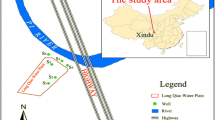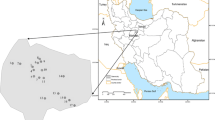Abstract
In this study, the drinking groundwater quality of Lenjanat plain, Iran, is classified based on water quality index (WQI), Takagi–Sugeno–Kang fuzzy water quality index (TSKFWQI) and entropy weighted water quality index (EWQI). Groundwater samples from 79 regional monitoring wells and different resources such as agricultural and potable deep wells, rural dug wells, industrial and recreational facilities and drilled wells in the vicinity of pollution sources of urban and rural sewage discharge points were collected and analyzed during 2009–2010. In this research, physicochemical parameters including As, Pb, Cr, Ni, Cu, NO3, Na, K, F, Cl, Ba, Ca, Mg, Fe, SO4 and TDS were used to calculate the drinking quality rank of water samples using WQI, TSKFWQI and EWQI methods. Calculations showed that ranking the groundwater samples using WQI is very similar to ranks determined by entropy-based calculations of water quality index, while the TSKFWQI clearly indicates that this classification method acts stricter than two other methods (WQI and EWQI). In TSKFWQI, the final rank of any sample is very much affected by toxic parameters. It means that a sample with acceptable range of all parameters, except one toxic parameter, falls in the unacceptable rank. As a result, in areas where water chemistry shows the presence of some toxic elements in the groundwater resources, TSKFWQI classification of water with regard to drinking purposes gives more reliable results.




Similar content being viewed by others
References
Castellanoa G, González-Santandera JL, Laraa A, Torrensb F (2013) Classification of flavonoid compounds by using entropy of information theory. Phytochem 93:182–191
Chang CI, Chen K, Wang J, Althouse MLG (1994) A relative entropy based approach to image thresholding. Pattern Recogn 27(9):1275–1289
Chang N, Chen HW, King SK (2001) Identification of river water quality using the fuzzy synthetic evaluation approach. J Environ Manag 63:293–305
Cude CO (2001) Water quality index: a tool for evaluating water quality management effectiveness. J Am Water Resour Assoc 37:125–137
Dahiya S, Kaur A (1999) Assessment of physico-chemical characteristic of underground water in rural areas of Tosham subdivision, Bhiwani-Haryana. J Environ Pollut 6:281–288
Dahiya S, Kaur A, Garg VK, Jain N (2000) Quantification of fluoride in groundwater in rural area of Tosham subdivision, district Bhiwani, Haryana. Environ Sci Pollut Res 19:417–419
Dahiya S, Datta D, Kushwaha HS (2005) A fuzzy synthetic evaluation approach for assessment of physico-chemical quality of groundwater for drinking purposes. Environ Geol 8:158–165
Deshpande AW, Raj DV, Khanna P (1996a) Fuzzy description of river water quality, Paper for International Conference EUFIT
Deshpande AW, Raj DV, Khanna P (1996b) Agreement Index for water consumption. Paper for international conference EUFIT
Duque WO, Huguet NF, Domingo JL, Schuhmacher M (2006) Assessing water quality in rivers with fuzzy inference systems: a case study. Environ Int 32:733–742
Garg VK, Dahiya S, Chaudhary A (1998) Fluoride distribution in underground waters of Jind district, Haryana, India. Ecol Environ Conserv 4:19–23
Geological Survey of Iran (1976a) Geological Map of Iran 1:100000 Series, Sheet 6354 Shahreza. Ministry of Industry and Mines
Geological Survey of Iran (1976b) Geological Map of Iran, 1:100000 Series, Sheet 6254 Riz-e-Lenjan. Ministry of Industry and Mines
Gharibi H, Mahvia AH, Nabizadeha R, Arabalibeikd H, Yunesiana M, Sowlatf MH (2012) A novel approach in water quality assessment based on fuzzy logic. J Environ Manag 112(15):87–95
Gibbs RJ (1970) Mechanisms controlling world water chemistry. Science 17:1088–1090
Guleda OE, Ibrahim D, Halil H (2004) Assessment of urban air quality in Istanbul using fuzzy synthetic evaluation. Atmos Environ 38(23):3809–3815
Icaga Y (2007) Fuzzy evaluation of water quality classification. Ecol Indic 7:710–718
Iranian Ministry of Energy (1985) The report of geophysical studies in Mobarakeh (Isfahan). Department of Groundwater (in Persian)
Jafarian MA (1985) The project of soils studies in Mobarakeh Steel Co. Isfahan University, Isfahan (in Persian)
Karmakar S, Mujumdar PP (2006) Grey fuzzy optimization model for water quality management of a river system. Adv Water Resour 29:1088–1105
Khaiwal R, Garg VK (2006) Distribution of fluoride in groundwater and its suitability assessment for drinking purposes. Int J Environ Health Res 16:163–166
Kord M, Asghari Moghaddam A (2014) Spatial analysis of Ardabil plain aquifer potable groundwater using fuzzy logic. J King Saud Univ Sci 26(2):129–140
Lermontova A, Yokoyamab L, Lermontovc M, Augusta Soares Machadod M (2009) River quality analysis using fuzzy water quality index: Ribeira do Iguape river watershed, Brazil. Ecol Indic 9(6):1188–1197
Lia Z, Guc J, Zhuanga H, Kanga L, Zhaoa X, Guoa Q (2015) Adaptive molecular docking method based on information entropy genetic algorithm. Appl Soft Comput 26:299–302
Liou S, Lo S, Wang SA (2004) Generalized water quality index for Taiwan. Environ Monit Assess 96:35–52
Mitchell MK, Stapp WB (1996) Field manual for water quality monitoring: an environmental education program or schools. Thomson-Shore Inc., Dexter, Michigan, p 277
Nassery HR, Kayhomayoon Z (2013) Source of salinity in the groundwater of Lenjanat plain, Isfahan, Iran. Environ Earth Sci 68:413–427
Ocampo-Duquea W, Osorioa C, Piambaa C, Schuhmacherb M, Domingoc JL (2013) Water quality analysis in rivers with non-parametric probability distributions and fuzzy inference systems: application to the Cauca River, Colombia. Environ Int 52:17–28
Parsabe Sepahan Andish (2008) The project of contaminants recognition in Zarinshahr, 13 vols. Zarinshahr Municipality (in Persian)
Piplani R, Wetjens D (2007) Evaluation of entropy-based dispatching in flexible manufacturing systems. Eur J Oper Res 176:317–331
Saberi Nasr A, Rezaie M, Dashti Barmaki M (2013) Groundwater contamination analysis using Fuzzy Water Quality index (FWQI): Yazd province, Iran. Geopersia 3(1):47–55
Said A, Stevens D, Selke G (2004) An innovative index for evaluating water quality in streams. Environ Manag 34:406–414
Sarath Prasanth SV, Magesh NS, Jitheshlal KV, Chandrasekar N, Gangadhar K (2012) Evaluation of groundwater quality and its suitability for drinking and agricultural use in the coastal stretch of Alappuzha District, Kerala, India. Appl Water Sci 2:165–175
Sargaonkar A, Deshpande V (2003) Development of an overall index of pollution for surface water based on a general classification scheme in Indian context. Environ Monit Assess 89(1):43–67
Shannon CE (1948) A mathematical theory of communication. Bell Syst Tech J 27(379–423):623–656
Shen GQ, Lu YT, Wang MN, Sun YQ (2005) Status and fuzzy comprehensive assessment of combined heavy metal and organo-chlorine pesticide pollution in the Taihu Lake region of China. J Environ Manag 76(4):355–362
Shuiabi E, Thomson V, Bhuiyan N (2005) Entropy as a measure of operational flexibility. Eur J Oper Res 165:696–707
Shyu GS, Cheng BY, Chiang CT, Yao PH, Chang TK (2011) Applying factor analysis combined with kriging and information entropy theory for mapping and evaluating the stability of groundwater quality variation in Taiwan. Int J Environ Res Public Health 8:1084–1109
Silvert W (2000) Fuzzy indices of environmental conditions. Ecol Model 130:111–119
Wang HY (2002) Assessment and prediction of overall environmental quality of Zhuzhou City, Hunan Province, China. J Environ Manag 66(3):329–340
Yu S, Liu Y (2011) Evolution of regional transport structure information entropy and its dynamic analysis. J Transp Syst Eng Inform Technol 11(4):91–96
Zou ZH, Yun Y, Sun JN (2006) Entropy method for determination of weight of evaluating in fuzzy synthetic evaluation for water quality assessment indicators. J Environ Sci 18(5):1020–1023
Author information
Authors and Affiliations
Corresponding author
Rights and permissions
About this article
Cite this article
Kamrani, S., Rezaei, M., Amiri, V. et al. Investigating the efficiency of information entropy and fuzzy theories to classification of groundwater samples for drinking purposes: Lenjanat Plain, Central Iran. Environ Earth Sci 75, 1370 (2016). https://doi.org/10.1007/s12665-016-6185-1
Received:
Accepted:
Published:
DOI: https://doi.org/10.1007/s12665-016-6185-1




